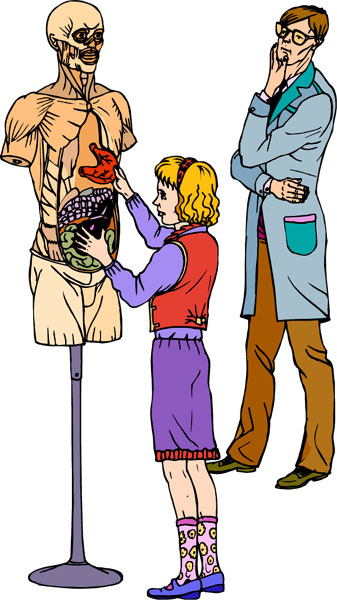Anatomy
We all talk and sing without knowing the names of the different organs involved or their function in voice production. Still, to be a professional singer and overcome obstacles and technical challenges - it is of utmost importance to get to know the vocal instrument, the different parts of it and how they should be used efficiently. Learning what needs to be done is the first step; later in class we learn how to coordinate all these parts together. This process takes longer since it involves Muscle Memory; the student needs to “forget” her/his bad habits and then learn new, healthier ones.
Why Study Anatomy?
In his book The Structure of Singing: System and Art of Vocal Technique, Richard Miller quotes:
In every field the man who can merely do things without knowing why is at a disadvantage to the one who can not only build but also tell you just why he is building in that way. This is especially noticeable when the prescribed cycle does not obey the laws it is supposed to: then the laborer must sit by with folded hands while the mechanic or engineer comes in and adjusts the delicate mechanism.
~ Reuben Fine, The Ideas Behind Chess Openings
There are many reasons why it is important for singers to study anatomy, I listed some below:
- When working together, we establish our mutual vocabulary and terms. If we use the scientific word - we have a better chance of addressing the precise same matter. And when you move on to the next teacher - some of the vocabulary is already established, which saves a lot of time.
- Knowledge increases awareness. When you learn about different parts of the vocal apparatus, you begin to feel how you use those organs and can consciously correct.
- Learning about the complexity of the voice and about how delicate it is often makes the singer more respectful and careful.
- Most of the singers will teaching at one point or another. As a teacher it is your duty to know what you are dealing with.
- Using those scientific words make us sound more sophisticated ☺.

Some teachers and students believe that too much information only causes confusion. I believe that facts are less a source of confusion than imagery (how do I pretend that I am a bird?). It’s true that too much of either is not good; If you feel confused, let go for a while and then return to study it in a slower pace, one fact at a time.
▲top
Terms
Below are some of the most important terms for singers; every day learn a couple of terms and you will finish the list in no time:
Vocal folds (cords): the vibrator that produces the sound. The most precious and delicate part of your voice, guard it well. Vocal folds were developed to prevent food and liquid from entering the lungs. Humans developed those muscles to produce speech.Larynx: voice box, Adam’s apple, where the vocal folds rest.
 Pharynx: a hollow tube inside the neck; this cavity provides resonance to the voices produced by the vocal folds.
Pharynx: a hollow tube inside the neck; this cavity provides resonance to the voices produced by the vocal folds.Oral Cavity: mouth, buccal cavity; this cavity provides resonance to the voices produced by the vocal folds.
Nasal Cavities: passageway from the nostrils to the back of the throat; provides resonance only on nasal consonants and vowels (for example the consonants m, n, ŋ or the French nasal vowels ɑ̃, ɛ̃, æ̃, ɔ̃).
Vocal Tract: the resonator, where the sound is filtered (consists mainly of pharynx and mouth)
Palate: consists of the Soft Palate or velum (should be raised in singing, as in yawning) and the Hard Palate (where we “send” the air and resonate the different vowels).
Thorax: chest, the part of the human torso between the neck and the diaphragm.
Sternum: also called chestbone or breastbone. It connects to the rib bones via cartilage. The sternum should always be presented - it creates a noble posture and allows for more efficient breath.
Ribcage: the bony enclosing wall of the chest; the ribs. When singing, expand the ribcage sideways and backwards. Not upwards.
Lungs: their average capacity is between 4 and 6 liters (adults), but we use very little for singing. The trick is to use the air efficiently. See the Breath section.
Diaphragm: we cannot control it directly; we can and do control the abdominal, dorsal and thoracic muscles that move the ribcage and the diaphragm which is connected to it. In proper singing it goes lower.
Intercostal Muscles: muscles that run between the ribs and move the ribcage. The External Intercostal Muscles expand the ribcage during inhalation and the Internal Intercostal Muscles decrease the size of the ribcage during exhalation.
Abdominal Muscles: develop awareness for the different muscles. Learn to control them, strengthen them and work on their flexibility. While singing they should be active and ready for action but not tight and tense.
▲top
Anatomy Links
The information provided in this page is only the basics. We did not discuss how all those organs coordinate together to form the healthy singing voice. Read detailed information on the following links, or search the web yourself:
- About the Voice: How does your voice work? A very good summery by Lions Voice Clinic. Once you have read and understood this page - you have done most of your study.
- Speech: Explaining briefly all aspects of voice production.
- Detailed interactive Diagram of Human Mouth and Throat (Cut View).
- The Anatomy Lesson: larynx, pharynx, thorax muscles, respiration, and more.
▲top
Anatomy Quiz
- Think of another reason why anatomy lessons are important for singers. E-mail your answer.
- Define one (or both) of the terms: ‘xiphoid process’ or ‘palatum molle’ and explain how they are used in singing. E-mail your answer.
- Find an impressive scientific name to a simple organ. Explain how this organ is used (or not) in singing (it doesn’t have to be part of the vocal tract or the breath mechanism). E-mail your answer.
- Find a website (not mentioned above) providing useful anatomy information for singers. E-mail your answer, and I might include it in the list of links!
▲top ► Vocal Health

